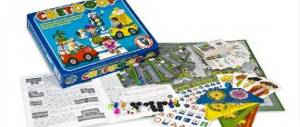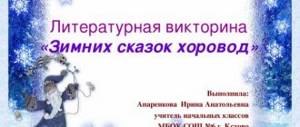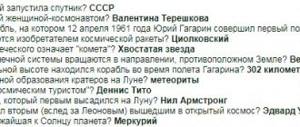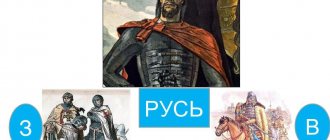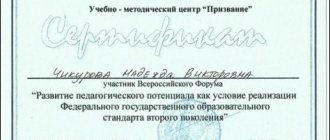Author of the material: Natalya Mikhailovna Svirina -
Head of the Department of General and Special Pedagogy, Professor, Doctor of Pedagogical Sciences. Institute of Special Pedagogy and Psychology. Saint Petersburg.
Expert: methods of teaching literature, reading
It is well known that the game is, according to L.S. Vygotsky, the leading activity of children, which is skillfully used by teachers of primary schools, fifth and sixth grades. However, a correctly constructed game, aimed at both the outcome (victory) and the process (preparation for the game), activates the cognitive interest of high school students in the field of the subject “Literature.”
Schoolchildren who read books lack the opportunity to discuss them with someone who is also interested in such communication; those who have not yet read, being in the center of the discussion, get the opportunity to hear and learn about the book not only from the teacher, but also from their peers.
More and more, the holistic impression of a book that schoolchildren received as a result of a smart lesson from a skillful teacher is disappearing from a literature lesson.
During the game, the passion of the team is always stronger than the personal ambitions of the individual, which is important from the point of view of education.
The commands can be:
- from one class (at the first stage of the teacher’s approach to such work),
- from parallel classes or even from different schools.
It also makes sense to organize literary tournaments in two stages: the winners of the intermediate stages advance to the last stage.
According to our observations, today's schoolchildren really lack general interesting active activities related to culture and art, in which the children will not show their own leadership inclinations, but will represent and defend the intellectual status of their gymnasium, school, lyceum.
It is worth noting that it is through intellectual play, that is, an active entertaining activity, that we strive to attract the attention of high school students to literary works, both studied in high school and familiar to students in the high school curriculum.
The game uses software works as the basis.
The game consists of two stages, in total (the game itself, preparation for it, training) lasts almost six months: from January, when the teacher and team decide whether to play or not to play, until April, when the decisive final takes place.
All details of the organization of the game can be found on the website of the Association of Gymnasiums of St. Petersburg
Tasks
The tasks for the first qualifying round are given differently every year.
Once it was an interpretation (oral presentation and written equivalent) of one of three works chosen by the team: E. Zamyatin “Dragon”, T. Tolstaya “Seraphim”, Y. Buida “Tower”. As an assignment, the preparation of “Tales about a poet of the 19th century” may be proposed.
In the first round, teams get to know each other and can compare their literary preferences and ideas with the level and knowledge of other teams - their peers. Questions are asked by both schoolchildren and members of the qualifying round jury.
Below we present game plans with examples of specific tasks with the necessary methodological comments.
Mind games. Intellectual game for teenagers
- Mind games
- 1.Every modern school should have at least three exits: the main one, the emergency one and...
- 2.Just two hundred years ago, they, so familiar to every man, did not yet exist. The reason for their occurrence was that in the 19th century large quantities of some daily necessary goods were stored as tightly as possible for shipment overseas. Now, speaking about them, we can remember a girl pop group, or a criminal term. And more often we see them in front of girls. What is this?
- Answer: Arrows
- 3. Guess whose joke this is. “He requires a lot of toys and gadgets. So he tries to ask a stupid question. Touch it with your finger and it will start. Complains about lack of memory. He loves it when dust particles are blown off him and wiped with alcohol. Always dreams of getting online.
Computer
4. It can be warm, friendly, relaxed, intense, healthy, polluted, earthy...
Atmosphere
5. In England, this flower is sung by poets in fairy tales: it serves as a cradle for little fairies and gentle elves. His homeland is Persia, from there he migrated to Turkey, and in the 19th century. to Europe. In Holland there was a cult of this flower. In Amsterdam, two stone houses were bought for three bulbs of this flower.
.
6. Speaking at the American Association for the Protection of Children, the great comedian Chaplin addressed his little listeners with the following advice: “Brush your teeth every day so that you will never be ashamed...” Finish the advice!
laugh
7. In addition to poison, it contains a large amount of proteins, carbohydrates, vitamins and amino acids. It is believed that a specially prepared tincture from it helps with articular rheumatism. It is also effective in fighting insects, as its name suggests. Name it.
8. Recently, a new diet has become fashionable in Italy. Its essence comes down to consuming foods in a strictly defined sequence. You should start eating, for example, with raspberries or tomatoes. Then, after a short break, you can lean on bananas. And for dessert - greens, cucumbers or kiwi fruits. By definition, both “white deaths” – sugar and salt, as well as black caviar and eggplant – fall out of this diet. If you understand the principle on which this diet is based, you can easily write its name.
9.
The work you know well describes the birth of the main character, her development, her color and becoming. This work also mentions two seasons, two representatives of the fauna - a rodent and a predator, an elderly man and children. I hope all of the above is enough to name the main character of this work. Name it.
10. Informal Crimea, the most famous and popular resort on the southern coast. The city was founded by Greek settlers on the site of Taurus settlements of the V-IV centuries. BC. According to legend, after a long storm, one of the sailors, seeing the land, shouted: “Yalos!”, which means “shore.”
- Yalta
11.
French schoolchildren use a convenient rhyming phrase, which in Russian translation sounds like this: “How once Jacques the city bell-ringer broke the lantern . What do Russian schoolchildren use in such cases?
“Every hunter wants to know where the pheasant sits”
12.
In Ancient Egypt, oily hair was considered beautiful, so the Egyptians lubricated it generously with fat. On funeral days, it was customary to sprinkle ashes on the head. One day, during a funeral, it started to rain, and at that moment, as the legend goes, people invented something that played a significant role in the life of mankind. What did they invent?
Soap
13.Who connects these two buildings?
- M.V. Shchepkin
14. It was presented in honor of the three hundredth anniversary of the reunion of two “sisters”
February 19, 1954. March 18, 2014 - the gift returned home.
15. Vasya Pautinkin, visiting there every day, often encounters trouble that “climbs from all sides” and greatly bothers him. But he quickly dealt with it. How?
Installed a filter on your browser
Task 3. Games in literature (orally). Who plays, from what literary work?
Marks: for 0.5 points for each correct answer: author, title, name of the hero. Maximum – 1.5 points. An example of such a task: “Are you hitting my card or not?
Other works, episodes: the game of burners from “The Peasant Young Lady” by A.S. Pushkin (Nastya, Liza Muromskaya’s maid, head of “The Game” tells about Alexei Berestov), L. Tolstoy’s “Childhood”, carols from. “The Nights Before Christmas” N.V. Gogol; Knurov and Vozhevatov play heads or tails, act 4, scene 6, A.N. Ostrovsky “Dowry”, M.Yu. Lermontov “Hero of Our Time”, chapter “Fatalist” (“There was only one passion that he did not hide: a passion for the game”).
In this task, those heroes of various classical works who, one way or another, indulged in the game, come together. A common theme, uniting characters who are not at all similar to each other, reveals the most striking properties of the characters and helps not only to recognize familiar, memorable characters, but also to remember forgotten images. The unifying feature should not be any common feature, but one that is consonant with or understandable to high school students.
Download material
so UNT / Educational work / Scenarios
Intellectual quiz for high school students “What? Where? When?"
10.18.2014 12735 1043 Nauruzbaeva Gulnara Sovetovna
Target
: enrich and broaden the horizons of students.
Tasks:
develop intelligence, promote the development of thinking and cognitive activity of students.
1) In India, not far from Bombay in the Arabian Sea, there is an island of Elephants. There are no live elephants on it, but they sell wooden ones. The rarest elephants, the most expensive ones, are made of special wood. Which one? (White Santal. Wood is expensive because it has a special, Santal-like smell.)
2) The wood of this tree is so good that in the 18th century this tree in Burma was declared the property of the royal family. The wood does not warp, wear out or rot in water. An iron nail driven into raw wood and after 100 years it’s as good as new. Does not take wood or chemicals. Termites cannot approach it either. For hundreds of years, ships made of this wood plied the seas and oceans, and nothing became of them. The tree grows quickly: a meter per year, forty meters in forty years. What kind of tree is this? (Teak.)
3) What tree did the Arabs say about: “Queen of the oasis.” She bathes her feet in water, and her beautiful head in the fire of the sun’s rays”? (Palm.)
4) The highest mountain state? (Nepal.)
5) Number with 15 zeros? (Quadrillion.)
6) In which country were martial arts popular all over the world created: judo, karate, aikido? (Japan.)
7)Which game is named after a UK city? (Badminton.)
 What bird bears the name of the famous Russian writer? (Gogol.)
What bird bears the name of the famous Russian writer? (Gogol.)
9) The most “sunny” geometric figure? (Ray.)
10) The most famous star in the constellation Ursa Minor? (Polar.)
11) A measure of the weight of precious stones. (Carat.)
12) Part of a circle bounded by an arc and its chord. (Segment.)
13) In what city and when did they first measure angles in degrees? (More than 3 thousand years ago in Babylon.)
14) What is the name of the device that performed all four arithmetic operations, which was created in 1673 by the German mathematician and physicist Gottfried Wilhelm Leibniz? (Adding machine.)
15)What is the name of the science of measuring the earth? (Geodesy.)
16) Which flower is a symbol of the sun and a symbol of Japan?
(Chrysanthemum.)
17) Sherlock Holmes' most famous line? ( "Elementary Watson".)
18) What is the second “culinary” name of the green turtle? (Soup.)
19) Which doctor, according to legend, took the form of a snake to save Rome from an epidemic? (Aesculapius.)
20) What would happen to our Earth if it suddenly stopped its rotational motion? (Due to gravitational forces, it would fall into the Sun.)
21) In which country did the first roller skates appear? (IN THE USA.)
22) What birds were kept in gold and silver cages during the time of Alexander the Great? (Parrots.)
23) What do hummingbirds eat? (Flower nectar.)
24) Which plant has the largest flower in the world? (In Rafflesia Arnoldi from the island of Sumatra.)
25) Which plant in Chinese means “man is the root”? (Ginseng.)
26) The word “hippo” translated from Latin means “horse”. The name of which animal is translated as “river horse”? (Hippopotamus.)
27) What is the biggest fish in the world? ( Whale shark.)
28) What three religions are called world religions? (Buddhism, Islam and Christianity.)
29) Name the highest point on Earth and its height. (Everest, 8848 m.)
30) Name the lowest point of the Earth, its depth. (Mariana Trench, 11022 m.)
31) A large falcon, only slightly smaller in size than the gyrfalcon. It feeds on both birds and small mammals, including ground squirrels. Of the birds, it overpowers not only partridges, but also large ducks, and a trained bird can take on larger prey - even a beautiful bustard. It is for the sake of this loot that Arab sheikhs buy them. Listed in the Red Book of Kazakhstan. What kind of bird is this? (Saker Falcon).
32) Name the “colored” seas. (Black, Red, Yellow, Marble.)
33) Founder of modern astronautics? (K.E. Tsiolkovsky.)
34) Name the English industrialist who, in the 18th century, invented and produced special thick paper to the delight of all draftsmen. (George Whatman.)
35) What machine was invented by the Englishman James Watt in 1774? (Steam engine.)
36) Which German mathematician, in 1693, introduced the modern notation of proportion using a colon and a division sign? (G.V. Leibniz.)
37) In 1557, the English physician Robert Record introduced a mathematical symbol. Which? ( Equal sign.)
38) Which French mathematician introduced the symbol to denote an angle in the 17th century? (P. Erigon.)
39) Which English mathematician introduced the term “discriminant”? (D.D. Sylvester (1814-1897), he called himself the “mathematical Adam” for the many coined terms.)
40) In 1801, T. Jung discovered the phenomenon of interference, using for this a common children's game, familiar to most of us and proverbial because of its frivolity. (Bubble.)
Teacher of KSU “Secondary school No. 33 named after K. Ryskulbekov”
Nauruzbaeva G.S.
Semey
See the downloadable file for the full text of the material.
The page contains only a fragment of the material.
Task 6. Homes of literary heroes
Fragments are read aloud. In written answers you must indicate the author, title, and character. Rating: author, title – 0.5 points, hero – 0.5 points.
Other fragments of this task are taken from the following works:
Depending on the time, this task can also be carried out orally, reading aloud all the above episodes, but addressing each to only one team in turn.
Task 7. Finish the story: suggest a possible ending.
The point of such work is to immerse schoolchildren in the author’s world as much as possible. Teams must try to reconstruct the meaning of the last phrase and guess at a possible name.
Author of the assignment, teacher of school No. 348 E.K. Liforenko, offers V. Grossman’s story “Outside the City”. Of course, a story or short story for such a competition should be small in volume; the text is read (without indicating the title and last phrase) aloud and then distributed to the teams for a few minutes.
Here are some versions of the last phrase and names proposed by the teams who were given a few minutes to do this.
After all the versions have been heard, the presenter reads the ending of V. Grossman’s story.
Such tasks are useful not only in the game, but also in the lesson: by engaging the creative imagination of schoolchildren, such work mobilizes the general memory of the mood of the work of art.
Intellectual game for high school students “The Last Hero”
Malakhova Olga Anatolyevna
MOBU Secondary School No. 24, Sochi
Game for high school students
"The Last Hero of Fort BAZILYARD "
(based on the principle of the TV game “Fort Bayard”)
Somewhere in the school, for example in some classrooms, “treasures” are hidden in advance. The task of the players (two teams) is to find them. You can hide one “treasure” and develop two different routes, or you can hide your own for each team.
The game is divided into several stages. At each stage, teams receive hints. A correctly interpreted hint allows you to move in the right direction. False or misinterpreted will lead to a dead end
Stage 1: teams solve a crossword puzzle. The crossword is unusual: the questions are connected personally with the guys. Certain letters in the crossword puzzle form a word. This is a hint. In our case it was the word “Mayakovsky”. It is clear that in the literature room this clue should be looked for in books. There is a 12-volume edition of Mayakovsky on the shelf.
Stage 2: 12 volumes. Each one contains a leaflet with a hint. You can find out which volume you need by putting together a picture from a puzzle. Picture size A3. The editing was done in advance in Photoshop. Again about the guys. On one there are 4 boys, on the other 2. These are the volume numbers.
Stage 3 : In one of the volumes there is a portrait of Lermontov. Lermontov really “holds” the clue. There is a statuette of a poet on the cabinet in the office. There is a sheet of paper in your hands. In another volume there is a portrait of Catherine II. In the office there is a wall newspaper dedicated to her. There is a sheet of questions attached to the back of the newspaper.
Stage 4: Both teams have the same questions. The answers to them are some combination of numbers. From the first digits it becomes clear that this is a cell phone number.
Stage 5 : We call. We get the answer: 1. “The golden grove in which the route map is hidden dissuaded me.” 2. “Frost and sun, so you can clearly see the route you have to take.”
Stage 6: In the volumes of Yesenin and Pushkin, respectively, there is a description of the route, moving along which the children will find treasures.
Stage 7: We are looking for the “treasure”. 1 team:
Comment: “The Past” is a cabinet of history. “Grove” is three frail flowers in pots in the corridor, “three wells” is a toilet. A “fork” is a staircase, without fighting gravity, we move down to the “parallel world”, i.e. to the second floor. Having looked at ourselves from the outside (in the mirror), we walk along the corridor to the history room. Let's go there. There is a chocolate bar and a note on the table:
On the fourth floor, where children will arrive after making two circles along the stairs (2 floors), there is a fire hose. This is about "anaconda". A note:
To do this, make a forward movement
to the negative side of the y-axis.
This, of course, is the physics room on the floor below. There is a note on the office door:
“WHAT YOU ARE LOOKING FOR IS UNDER YOUR FEET”
This is the key to the office, where the “treasures” await the guys - a charming chest of candies.
2nd team.
Comment: The Unified State Examination woman’s hut is the office of the head teacher who supervises the senior classes. "Olympus" - teachers' room. Hint on the mirror:
This is the teacher's room plan. There is a chocolate bar and a note in the closet:
In a flower pot (“grove”) on the floor above there is a note:
This is a toilet, on the door of which there is again a note:
“Look under your feet.”
Key to the history room. There's a "treasure" here.
Game over!
Task 8. Musical (written)
Score: maximum 2 points for each correct complete answer: give the name and author of the literary source.
Small musical fragments are heard in the recording (video):
This competition turned out to be the most difficult, despite the textbook works chosen. Each piece of music is written based on an existing literary plot known to schoolchildren.

